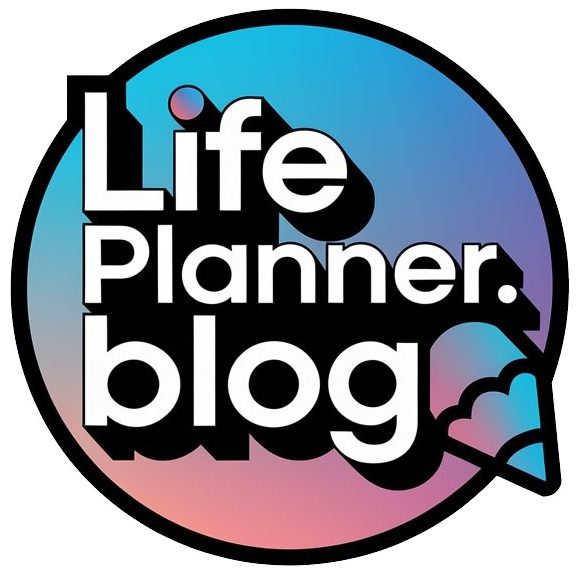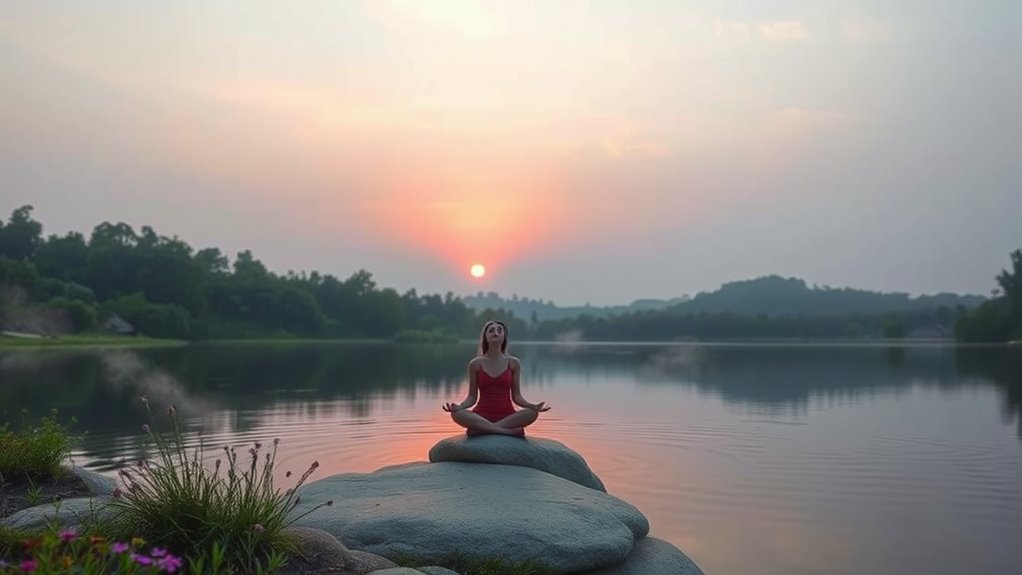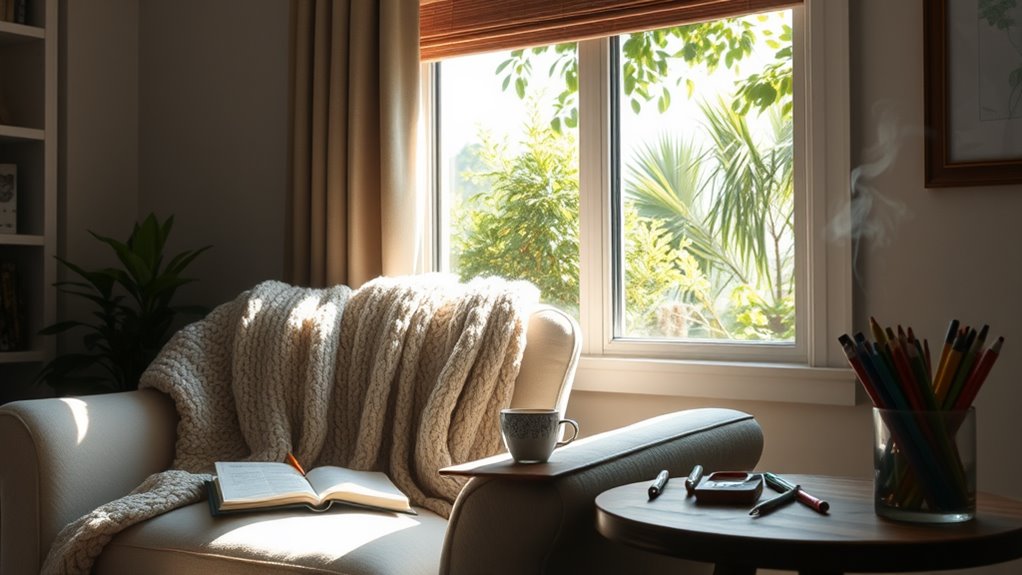Relaxation Techniques to Melt Away Stress in Minutes!
You can quickly melt away stress with simple relaxation techniques. Start with deep breathing; inhale deeply through your nose, expanding your belly, then exhale slowly through your mouth. Progressive Muscle Relaxation (PMR) is another great method; tense and relax different muscle groups, starting from your feet and moving up. Mindfulness meditation helps ground you in the present moment, while quick visualization techniques can transport you to calming nature scenes. Gentle stretches, like the Child’s Pose or Cat-Cow, can also ease tension. Discovering more ways to incorporate these practices can lead to even greater relaxation and peace.
Key Takeaways
- Practice deep breathing exercises by inhaling deeply through the nose and exhaling slowly to promote immediate relaxation.
- Engage in progressive muscle relaxation by systematically tensing and relaxing muscle groups to release built-up stress.
- Use mindfulness meditation to focus on your breath and the present moment, reducing anxiety and enhancing tranquility.
- Visualize serene nature scenes, engaging your senses to create a calming mental escape from daily pressures.
- Incorporate gentle stretching routines like Child’s Pose and Cat-Cow Stretch to relieve physical tension and promote relaxation.
Deep Breathing Exercises
When you feel stress creeping in, deep breathing exercises can be a powerful tool to regain your calm. One effective technique is diaphragmatic breathing, which involves breathing deeply into your diaphragm rather than shallowly into your chest. This method encourages a fuller intake of oxygen, helping to reduce anxiety and promote relaxation.
To practice diaphragmatic breathing, find a comfortable position, either sitting or lying down. Place one hand on your chest and the other on your abdomen. As you inhale through your nose, focus on expanding your belly, allowing it to rise while keeping your chest relatively still.
Exhale slowly through your mouth, feeling your abdomen fall. This breath awareness is essential; it helps you connect with your body and fosters a sense of control over your stress response.
Aim for a few minutes of this focused breathing each day, especially during stressful moments. You’ll notice that as you become more attuned to your breath, your tension lessens, and clarity emerges.
Progressive Muscle Relaxation
After mastering deep breathing exercises, you might want to explore another effective method for reducing stress: Progressive Muscle Relaxation (PMR). This technique helps you develop muscle awareness and achieve tension release throughout your body. By systematically tensing and relaxing different muscle groups, you’ll notice how stress can melt away, leaving you feeling more centered and calm.
To practice PMR, follow these steps:
- Find a quiet place where you can sit or lie down comfortably.
- Close your eyes and take a few deep breaths to help settle your mind.
- Begin with your feet, tensing the muscles for about five seconds, then releasing.
- Gradually work your way up through your body, focusing on one muscle group at a time.
As you engage in this process, you’ll become more attuned to the sensations in your body. PMR not only promotes relaxation but also enhances your ability to recognize and manage stress.
Mindfulness Meditation
Mindfulness meditation is an incredibly effective practice for reducing stress and enhancing overall well-being. By focusing your attention on the present moment, you can cultivate a deeper sense of awareness and tranquility. This practice not only helps you manage stress but also offers numerous mindfulness benefits, such as improved concentration and emotional regulation.
Here’s a quick overview of some key mindfulness meditation practices:
| Practice | Description | Benefits |
|---|---|---|
| Breath Awareness | Focus on your breath, noticing each inhale and exhale. | Reduces anxiety, promotes relaxation. |
| Body Scan | Mentally scan your body, releasing tension from each area. | Enhances body awareness, releases stress. |
| Loving-Kindness | Send love and kindness to yourself and others. | Increases compassion and empathy. |
| Guided Meditation | Follow a recorded meditation to stay focused. | Eases entry into meditation, reduces distractions. |
Integrating these practices into your daily routine can lead to profound changes in your stress levels and overall mental health. So why not give mindfulness meditation a try? You might be surprised at how quickly it can help you feel more centered and at peace.
Quick Visualization Techniques
While many people think of meditation as a silent practice, quick visualization techniques can be just as effective for relieving stress and fostering a sense of calm.
These techniques often use guided imagery to transport you to serene nature scenes, allowing your mind to escape the pressures of daily life.
To get started, find a quiet space, close your eyes, and take a deep breath. Imagine a beautiful forest, a tranquil beach, or a picturesque mountain. Focus on the details—the sound of waves, the rustle of leaves, or the scent of pine.
Here are some tips to enhance your visualization experience:
- Choose your scene: Pick a nature setting that resonates with you.
- Engage your senses: Imagine the sights, sounds, and smells vividly.
- Practice regularly: Even a few minutes a day can make a difference.
- Use guided recordings: They can help you stay focused and deepen your experience.
Gentle Stretching Routines
Gentle stretching routines offer a fantastic way to release tension and promote relaxation in both the body and mind. Incorporating simple yoga poses into your daily routine can enhance flexibility benefits while calming your thoughts. Here are some effective stretches you can try:
| Stretch | Description |
|---|---|
| Child’s Pose | Kneel and sit back on your heels, stretching your arms forward. |
| Cat-Cow Stretch | Alternate between arching your back (cat) and lowering it (cow) on all fours. |
| Seated Forward Bend | Sit with legs extended, reach for your toes, and breathe deeply. |
| Standing Side Stretch | Stand tall, reach one arm overhead and lean to the opposite side. |
| Supine Spinal Twist | Lie on your back, draw one knee to your chest, and gently twist to the side. |
Each of these poses can help alleviate physical tension and promote a sense of calm. By dedicating just a few minutes daily to these gentle stretches, you’ll not only improve your flexibility benefits but also cultivate a deeper connection between your body and mind. So, why not incorporate them into your routine today?
Frequently Asked Questions
How Long Should I Practice These Relaxation Techniques Daily?
You should aim for at least 10 to 20 minutes of daily duration, practicing various techniques multiple times a week. Consistency is key for maximizing benefits, so find a frequency that fits your lifestyle.
Can I Combine Multiple Relaxation Techniques for Better Results?
Absolutely, you can combine techniques for enhanced relaxation! Mixing deep breathing with gentle stretching or visualization can amplify your results. Experiment with different combinations to find what works best for you, making each session uniquely effective.
Are There Specific Times of Day Best for Practicing Relaxation?
Yes, there’re specific times for relaxation. Morning benefits include setting a positive tone for your day, while evening routines help unwind and reflect. Experiment with both to discover what works best for you!
What if I Struggle to Focus During Mindfulness Meditation?
If you’re struggling with mindfulness distractions during meditation, try focusing on your breath, using guided sessions, or setting shorter time limits. These meditation tips can help you regain focus and deepen your practice effectively.
Can Relaxation Techniques Help With Chronic Stress or Anxiety?
Absolutely, relaxation techniques can greatly help with chronic stress or anxiety. By practicing mindfulness, you’ll experience its benefits, leading to stress reduction and improved mental clarity. It’s a powerful tool for mastering your emotional well-being.




